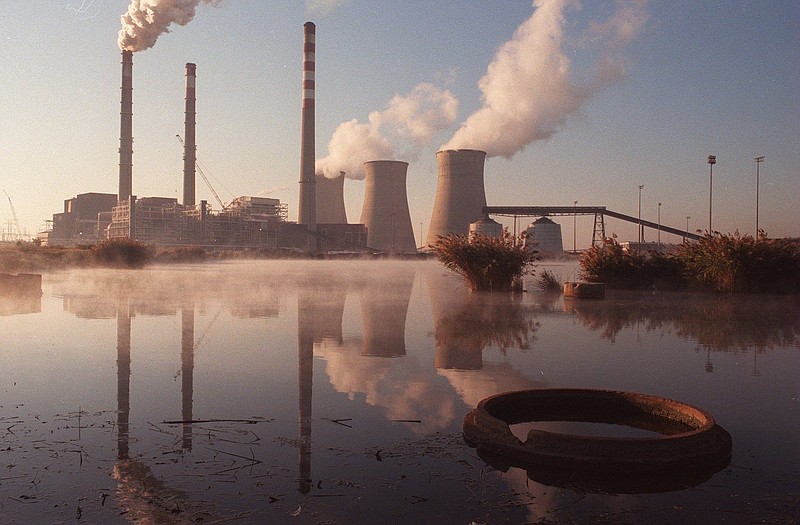Eighty-eight years after the Tennessee Valley Authority was created to harness the power of the Tennessee River, America's biggest public utility is turning to the sun, splitting atoms and natural gas plants to power its future.
The power shift outlined in a new strategic guide endorsed Thursday by TVA directors will phase out coal-fired power generation by 2035 to help limit the emission of greenhouse gases that contribute to global warming. TVA plans next week to give the required notice to begin the process of shutting down the two-unit Cumberland Fossil plant in Cumberland City, Tennessee - TVA's biggest coal plant - and by July TVA should give notice of its plans to close the nine-unit Kingston fossil plant in Kingston, Tennessee.
TVA President Jeff Lyash said the federal utility, which has already cut its carbon emissions by 63% in the past decade and a half, should cut its carbon output from the 2005 levels by at least 70% by 2030 and by 80% by 2035 when all of the coal plants are idled. Lyash said the carbon cuts should be made while keeping electric rates stable, boosting the electrification of transportation and maintaining TVA's 20-year-plus record of 99.999% reliability.
"We believe that maintaining balance between price, reliability, carbon reduction efforts and economywide electrification will deliver a sustainable economic advantage," TVA's strategic plan says.
TVA plans to add up to 10,000 megawatts of additional solar power generation by 2035, including 2,300 megawatts already underway for deployment within the next two years. That represents a 24-fold jump in solar generation, Lyash said.
TVA also is actively studying and planning to add a number of small modular reactors in Oak Ridge by 2032 to boost TVA's nuclear power generation which already supplies more than 40% of TVA's electricity.
TVA Chairman John Ryder said the federal utility emits only about half the carbon output per kilowatthour of its utility peers in the Southeast, primarily due to its seven operating nuclear reactors, which supply over 40% of TVA's power, and its 29 hydroelectric dams on the Tennessee River, which is what TVA originally built after its creation in 1933 and supply over 10% of TVA's power.
Over the past decade and a half, TVA has shut down most of the 59 coal-fired generators it once operated. TVA is preparing to shutter its Bull Run Fossil plant by 2023 and, subject to environmental studies and board approval, is planning to ultimately shut down all 25 of its remaining coal-fired units at Cumberland, Gallatin, Kingston and Shawnee coal plants by 2035.
"TVA is a national leader in carbon reduction and TVA is actively working to develop the energy system of the future," Ryder said after the board endorsed the decarbonizing strategy on Thursday.
TVA strategy guidelines
The TVA board Thursday adopted strategic principles which include:Building a carbon-free future* Phase out coal generation by 2035* More solar generation: TVA committed to adding 2,300 megawatts of solar power by the end of 2023 and to reach 10,000 megawatts of solar by 2035.* More nuclear power: Nuclear power generates 42% of TVA’s and TVA could add small modular reactors in Oak Ridge by 2032 to further boost nuclear output.* Carbon reduction goals: 63% reduction already in carbon since 2005 peak. Goal is 70% carbon reduction by 2030, 80% by 2035 and 100% carbon free by 2050Maintaining attractive energy costs & reliability* Stable rates: Plans to avoid base rate increase for next decade and maintain 99.999% reliability* Electricity prices are now lower than a decade ago* Residential rates below 70% of major utilities* Industrial rates below 90% of major utilitiesPromoting economic and job development* In the past five years, TVA recruited $45.4 billion of investment and added or retained 341,000 jobs* In the first half of fiscal 2022, TVA attracted $3.9 billion of investment with 45,200 jobs, including the biggest capital investment of $2.3 billion ever from GM and LG Chem for a battery plant in Spring Hill and the biggest single job addition of 8,500 jobs from Oracle in Nashville.Source: Tennessee Valley Authority
The TVA board adopted the strategy after a board retreat meeting and a briefing with U.S. Energy Secretary Jennifer Granholm.
TVA also has set a goal of achieving zero carbon emissions by 2050. That's 15 years after President Joe Biden wants America's electric industry to be carbon free in 2035.
Environmental leaders welcomed TVA's plans to phase out its aging fleet of coal plants - the oldest in the nation - while boosting solar and other renewable energy. But TVA is still building more natural gas plants to help meet peak demands and to generate power when the sun isn't shining or the wind doesn't blow.
"TVA is showing that cleaner power can help boost the economy and help consumers have lower costs and better health," said Jonathan Levenshus, director of federal campaigns at the Sierra Club's Beyond Coal Campaign.
But Levenshus said he thinks TVA could do more to achieve the carbon-free goal for the electric industry that President Biden has set for 2035 if it moved more aggressively toward renewable fuels, energy efficiency and storage technologies rather than adding more gas plants.
Stephen Smith, executive director of the Southern Alliance for Clean Energy, said TVA is still adding 1,500 megawatts of additional gas generation to offset some of the retiring coal plants. Smith said "TVA could lead by example and reach the carbon-free goal by 2030 if they take the necessary action now" and better align with the Biden administration targets for carbon reduction.
"With accountable leadership, collaborative planning, and commitment, TVA has the opportunity to once again embrace the mission to be a "utility yardstick" of innovative environmental stewardship and job creation," Smith said.
Lyash said the new combined-cycle, high-efficiency gas plants are more efficient than the gas and coal plants they are replacing and such generation not only reduces carbon output but is critical to meet power peaks and avoid outages like what hit Texas this winter when cold weather overwhelmed the state's power grid.
Lyash said to become completely carbon-free while still supplying electricity to power more vehicles on the road as cars shift from gasoline to batteries will require new technologies, including carbon capture sequestration for its natural gas plants and new methods of energy storage or nuclear generation.
"Nuclear is critical to achieving net-zero carbon emissions, " Lyash told the TVA board during a quarterly meeting in Knoxville. "TVA has been a leader in developing new nuclear technologies and we stand ready to help the nation lead in the development of small modular reactors."
In December 2019, TVA was awarded the first early site permit for two or more small modular reactors to be built in the Clinch River near the Department of Energy's Oak Ridge National Laboratory.
Lyash said TVA is also working to promote more electric vehicles to reduce carbon emissions in America's transportation sector. That is also paying dividends for Tennessee, which is home to three EV vehicle manufacturers and just landed the state's biggest single investment ever from a $2.3 billion battery plant planned in Spring Hill by GM and LG Chem.
Contact Dave Flessner at dflessner@timesfreepress.com or at 423-757-6340.

